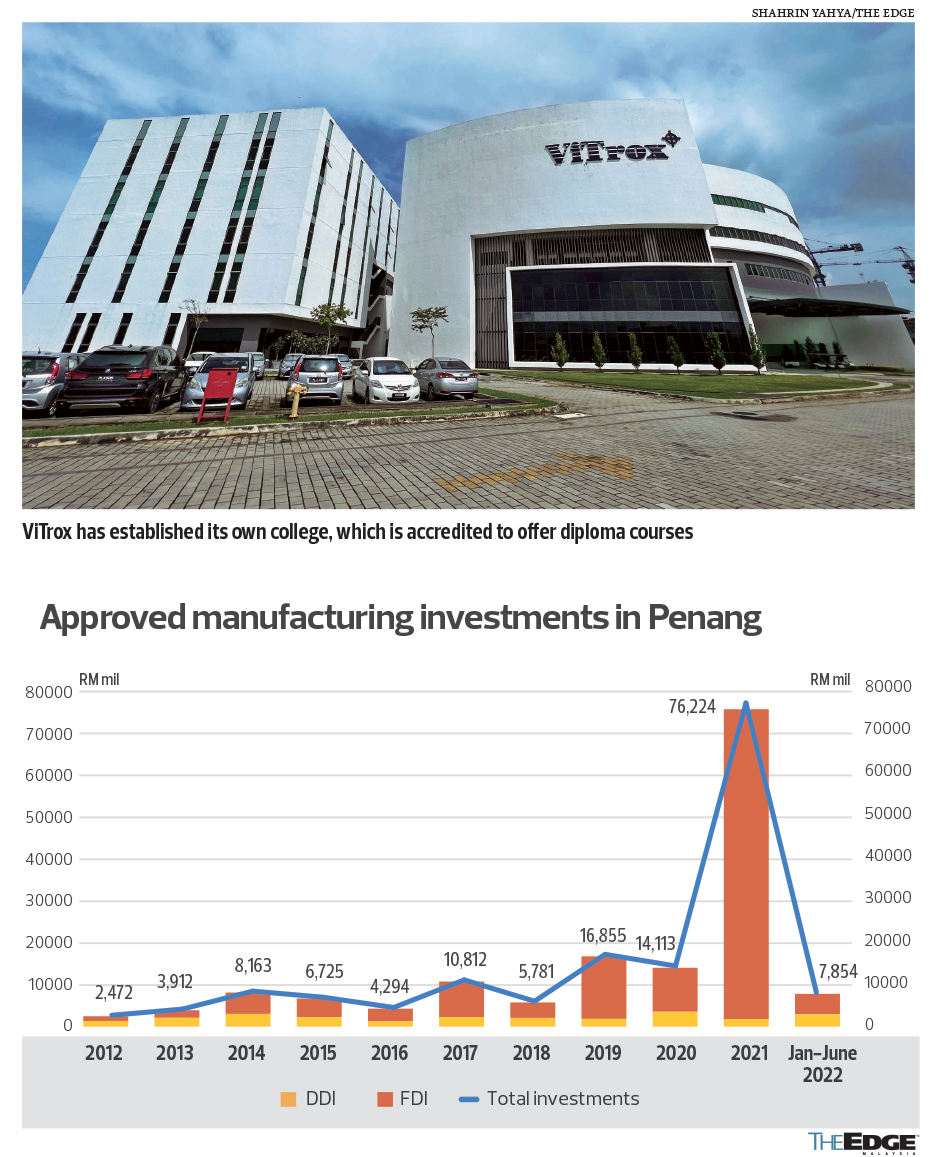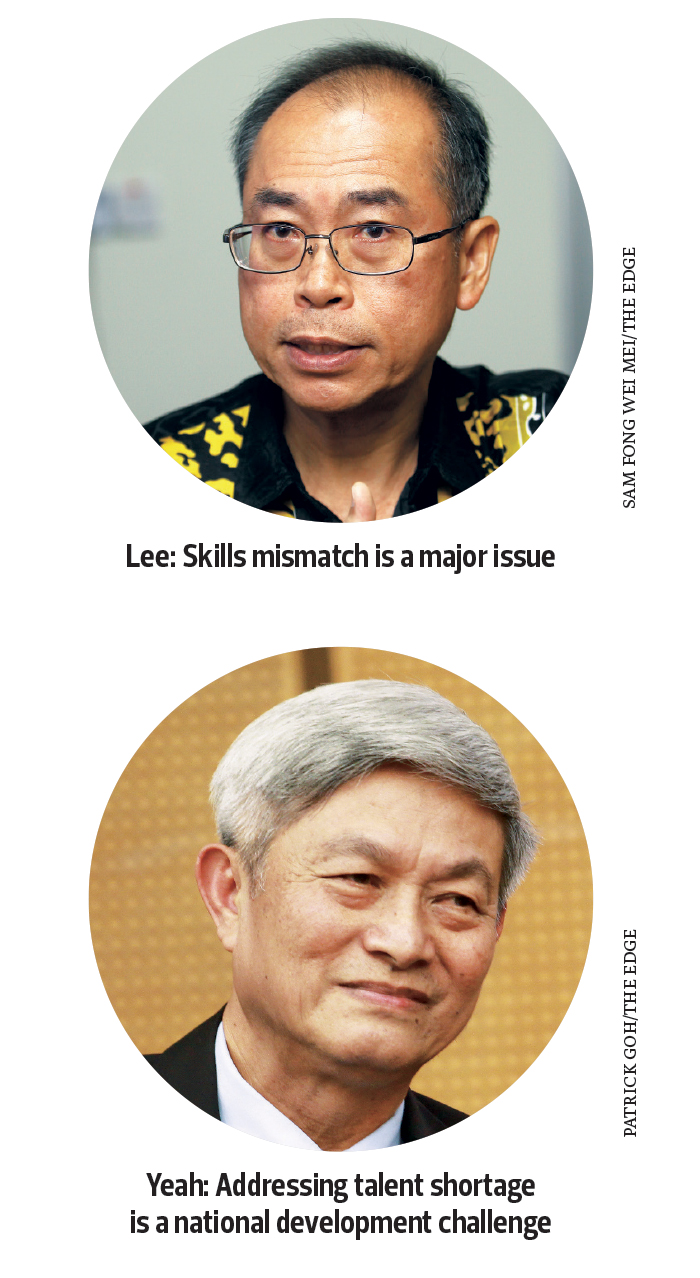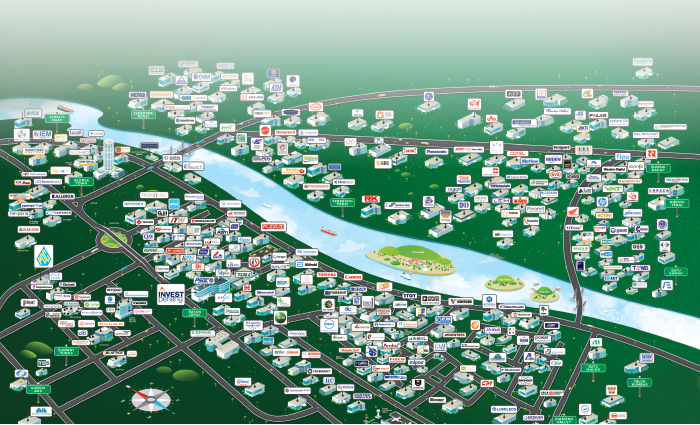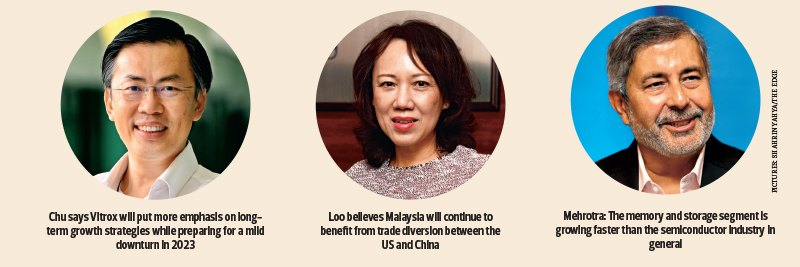
This article first appeared in The Edge Malaysia Weekly on December 12, 2022 - December 18, 2022
Hey! Anak-anak Penang, Penangites, Penang Kia, where are you? Penang is calling!” This can be found on the website of the Penang Career Assistance and Talent (CAT) Centre, a focused programme set up in 2009 by the management of Invest-in-Penang Bhd (InvestPenang) to attract talent to the state.
The website shows that there are currently about 6,000 career opportunities in Penang, including job vacancies for mechanical engineers, project engineers, IT software engineers and science lab technicians.
Last month, The Edge travelled to the state to meet captains of industry in the semiconductor and electrical and electronics (E&E) sectors. Surprisingly, most of them are not overly worried about the global chip downturn. Instead, their bigger concern was the huge shortage of talent in Penang, brought about by the massive flow of investments into the country’s industrialisation and E&E hub, which has been dubbed the Silicon Valley of the East.
To InvestPenang CEO Datuk Loo Lee Lian, being the state with the highest amount of foreign direct investment (FDI) in the country is a happy problem for Penang despite the talent shortage issues.
“The big challenge we are facing right now is the shortage of human talent. We all know this is happening everywhere, it is not just a Penang problem,” she tells The Edge in an interview.
Loo stresses that human talent is InvestPenang’s top priority at the moment. The state’s principal investment promotion agency has set a target of bringing in 150,000 talents in the next five years.
“Over the past 50 years, Penang has remained resilient and sustainable. We just have to keep on addressing all the challenges. There will never be a time when there are no challenges. I would say this is an exciting time for InvestPenang,” she remarks.
“When there are no investments, it is a challenge. When there are too many investments, it is also a challenge. So, which would be the happier headache? I think I would enjoy finding ways to address this interesting challenge.”
Penang currently houses more than 350 multinational corporations (MNCs) — including three of the top 10 global semiconductor giants and six of the top 30 global medical device companies — as well as more than 4,000 small and medium enterprises (SMEs).
Thanks to its strong and vibrant E&E ecosystem, the state accounts for over 5% of the world’s semiconductor sales. There are leading players in sectors such as integrated circuit (IC) test design, outsourced semiconductor assembly and test (OSAT), optoelectronics, storage and memory, printed circuit board (PCB) and substrates, as well as front- and back-end equipment manufacturing.
Despite the global uncertainties, Penang’s approved manufacturing investments hit an all-time high of RM76.2 billion in 2021. The figure not only surged 440% year on year, but also exceeded the cumulative investments of RM73.1 billion garnered from 2012 to 2020. It is estimated that more than 12,000 jobs have been created from the manufacturing investments in 2021 alone.
Taking a breather while waiting for labour market to consolidate
Loo says many mega projects — both greenfield or brownfield investments, including Intel Corp’s US$7 billion (RM30.8 billion) expansion in Bayan Lepas — were announced last year.
“2021 was a really excellent year for us. Will we achieve another record year? The answer is no. I don’t think the market can repeat that kind of stellar performance because the industry has to take a breather. One of the main reasons is human talent,” she adds.
Loo goes on to say that Penang has to “expand responsibly” while waiting for the labour market to consolidate. “If we bring in new investors and they cannot find talent, it will end up very bad. It is InvestPenang’s job to make sure that all the projects that come here will be successful,” she reiterates.
Loo observes that many new factories were completed this year, hence they commenced operations at about the same time. This means hiring workers in large numbers.
Moreover, existing E&E companies were expanding due to the semiconductor boom, while the US-China trade war had forced many companies to increase their production capacity in Penang.
“We are seeing expansion everywhere. To make things worse, due to the closure of borders, we weren’t allowed to bring in talents from other countries. All these are happening at the same time,” she says.
Hopefully, the talent shortage problem will be resolved by the middle of next year, given that the permits for foreign employees have been granted and issued gradually, says Loo.
“We have been telling Putrajaya that the requirements for the permits for foreign workers and professional talents should be relaxed. If you look at Singapore, it has been using foreign talents. Malaysia should also do that,” she adds.
“We should provide a relaxation for foreign talents with certain skill sets that are not available here. For example, we should encourage companies to bring in software engineers from India so we can train our people as well.”
Loo says InvestPenang will continue to bring in talents from other states and countries, as well as to develop and retain the local talents.
“We want to attract fresh university graduates to come to Penang. We have our campaign called ‘My Penang, My Workplace’. We have done a lot of sessions to share with university students the job opportunities in Penang. For many years, about 20% to 30% of the talents working in Penang are from other states,” she elaborates.
As the new investments cool down, Loo expects to see some improvement in terms of the talent shortage.
“It is important to note that when I say it is time for us to consolidate, it doesn’t mean we will stop companies from coming in. We have been attracting new investments strategically over the past few years. We do our due diligence. We know when to say yes, and we know when to say no,” she remarks.
“If a company comes to us today and says it needs 10,000 labourers, then most likely we will have no choice but to say no to them. We can’t be saying yes to everyone. If they came here and could not get talents, they would not do well and it would not look good on us either.”
Loo highlights that Penang encourages companies to automate and digitise as much as possible. “For instance, if you look at some of the MNCs that we brought in, they are already starting to automate their lines using equipment and machines supplied by our local automation houses,” she says.
Nevertheless, Loo opines that before the talent shortage issue is fully resolved, the existing talents are likely to move from one place to another within Penang, just like musical chairs, and that would eventually cause severe wage inflation.
“In fact, the salaries of our engineers have gone up over the past few years. Pre-Covid, fresh graduates could earn RM2,500 to RM2,800. Post-Covid, they can earn RM3,000 to RM3,500, or even more for certain companies. If our companies refuse to increase salaries, these talents would go to Singapore and Taiwan,” she observes.
According to industry sources, some MNCs operating at the Kulim Hi-Tech Park in Kedah are offering a 20% wage hike to lure talents from Penang, Perak and other states. So, what will the Penang companies do?
STEM education support
Datuk Sanjay Mehrotra, president and CEO of Micron Technology Inc, points out that the memory chip maker has put in a lot of effort to develop talents, build a culture of collaboration and improve the well-being of the team.
“We have strong engagements with the university ecosystem with respect to internships, where we provide help to students to develop the STEM (science, technology, engineering and mathematics) workforce. We have given a RM1 million grant to multiple universities towards graduate-level research on AI (artificial intelligence), smart manufacturing and materials development,” he tells The Edge.
Mehrotra says Malaysia has strong capabilities in terms of ecosystem, supply chain, logistics, manufacturing and infrastructure. “That is why we see the strong presence of many MNCs, especially in the area of assembly and test operations. Malaysia should continue to build on this strong capability.”
Micron has added nearly 4,000 jobs in Penang since 2019.
“I think this country is really enjoying tremendous benefits of the manufacturing strength that has been built here over the years,” he notes.
On attracting and retaining talents, Mehrotra says it is crucial to build a strong culture within a company, which is foundational to ultimately capturing future business opportunities.
“We really care for the community through various initiatives such as STEM education support and charity activities. We focus on diversity, equality and inclusion, as well as the wellness of our employees. We just launched a childcare centre in Batu Kawan through a public-private partnership. That shows how much we care for our employees and want them to have fulfilling careers,” he highlights.
Work-based learning
Notably, ViTrox Corp Bhd has established its own college, dubbed ViTrox College, which has obtained the Malaysian Qualifications Agency (MQA) accreditation to offer diploma courses in electronics, mechatronics and machine vision engineering.
According to ViTrox co-founder, CEO and president Chu Jenn Weng, his aim is to build a strong local ecosystem in Penang by emulating the Silicon Valley ecosystem in California.
“Next year, we will offer more diploma courses in computer science and industrial management. When the time is right, we will apply to offer engineering and computer science degree courses that will help us become a full-fledged university,” he says.
ViTrox College offers work-based learning diploma and Technical and Vocational Education and Training (TVET) courses. Its foundation is driven by real-world learning experiences and motivated by a lifelong interest in technology innovation and people competencies.
“Although it is MQA accredited, we are running it very differently. It is work-based and problem-based learning, with a lot of hands-on activities on solving real-world industrial problems together with engineers and technicians. Our lecturers are full-time, fully qualified and experienced. They have years of relevant experience in the fields,” says Chu.
He points out that apart from teaching the knowledge to solve real engineering problems, the college also cultivates the right mindset and culture through what ViTrox is doing.
“Our target for next year’s first batch is below 50 students. We emphasise quality education and we want to pay intensive attention to these students, ensuring that they will do well in their studies with proper guidance and mentoring before we scale,” he adds.
Meanwhile, ViTrox will start building the first block of its five-block Vitrox Institute of Technology (VIT) next year. VIT is anticipated to be a magnet to attract lecturers from around the world to come, teach and do research.
“Talent remains the biggest challenge to support our 10-year master plan. I will have to continue to think about getting, retaining and engaging the right people to expand our market worldwide, mitigating regional risk, as well as designing, developing and manufacturing the right products and solutions for our customers sustainably,” says Chu.
Responsibility of the government and MoE
Datuk Seri Lee Kah Choon, special adviser to the chief minister of Penang on economic affairs, believes the government and the Ministry of Education (MoE) should bear the responsibility for the shortage of talent.
“Skills mismatch is a major issue. The unemployment number for undergraduates in Malaysia shows serious issues in the education system that need to be tackled,” he warns.
Besides, the shortage of entrants into STEM courses also contributes to the issue, as the current system is not conducive to producing more graduates. Therefore, the MoE has to come out with a policy to encourage the younger generation to go into STEM education in university and vocational schools, says Lee.
He adds that sourcing talents from abroad could help address the talent gap in Malaysia. Hence, he suggests that the government introduce a long-term package for foreign talents.
“For example, Singapore is known as a leading destination for the world’s best foreign talent, thanks to its supportive government policy for foreign talents, such as offering permanent resident (PR) status to foreign talents. If you recognise these foreign talents are important to your country, what is wrong to give them PR status or make them citizens?” says Lee.
Sunway University Business School professor of economics Dr Yeah Kim Leng concurs that the talent shortage issue is partly due to a mismatch of skills between those required by industries and those produced by universities.
“A talent shortage typically arises either if the country’s industrial growth exceeds the supply of skilled labour or there is an undersupply problem. The undersupply could be due to capacity constraints faced by tertiary education institutions,” he says.
Another factor that results in undersupply is an outflow of talents, or more generally known as a “brain drain”.
“Most developing countries face brain drain due to more job opportunities, higher incomes and better living standards and quality of life in the more advanced economies. Addressing talent shortage is a national development challenge involving the education, international trade and industry, economic planning and human resources ministries. Better coordination among these ministries and greater engagement with the private sector, especially the affected industries, are necessary to find short- and long-term solutions to the perennial issue of talent shortage,” says Yeah.
He adds that universities will be a ready source to tap new talents, even though the existing study programmes that are directly related to industry needs may have to be expanded and better tailored.
“Another source is the overseas Malaysian talent pool, where the returning talents programme can be fine-tuned in collaboration with industry players. The government could consider topping up the incentives to lure back overseas talents,” Yeah suggests.
Save by subscribing to us for your print and/or digital copy.
P/S: The Edge is also available on Apple's AppStore and Androids' Google Play.





